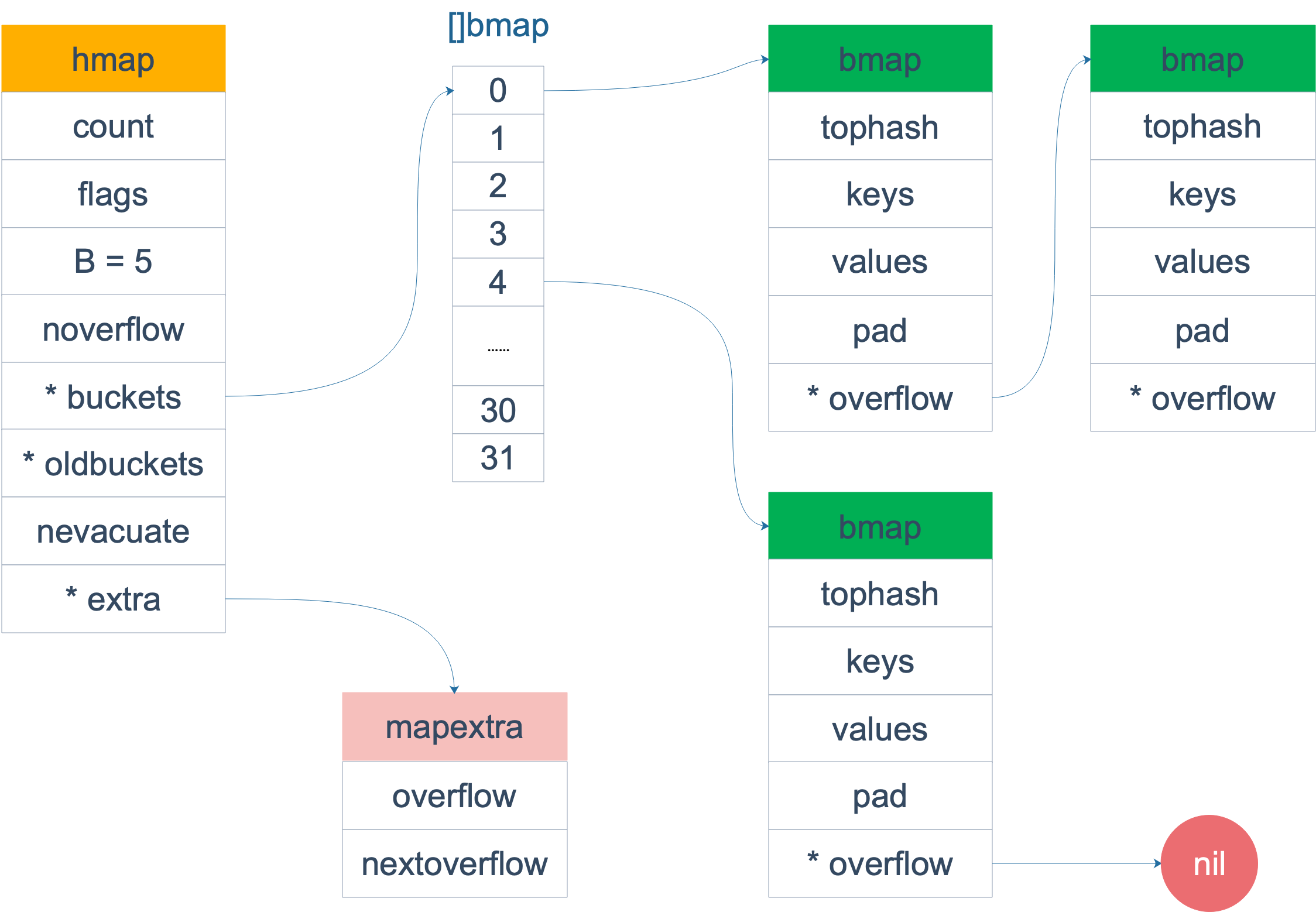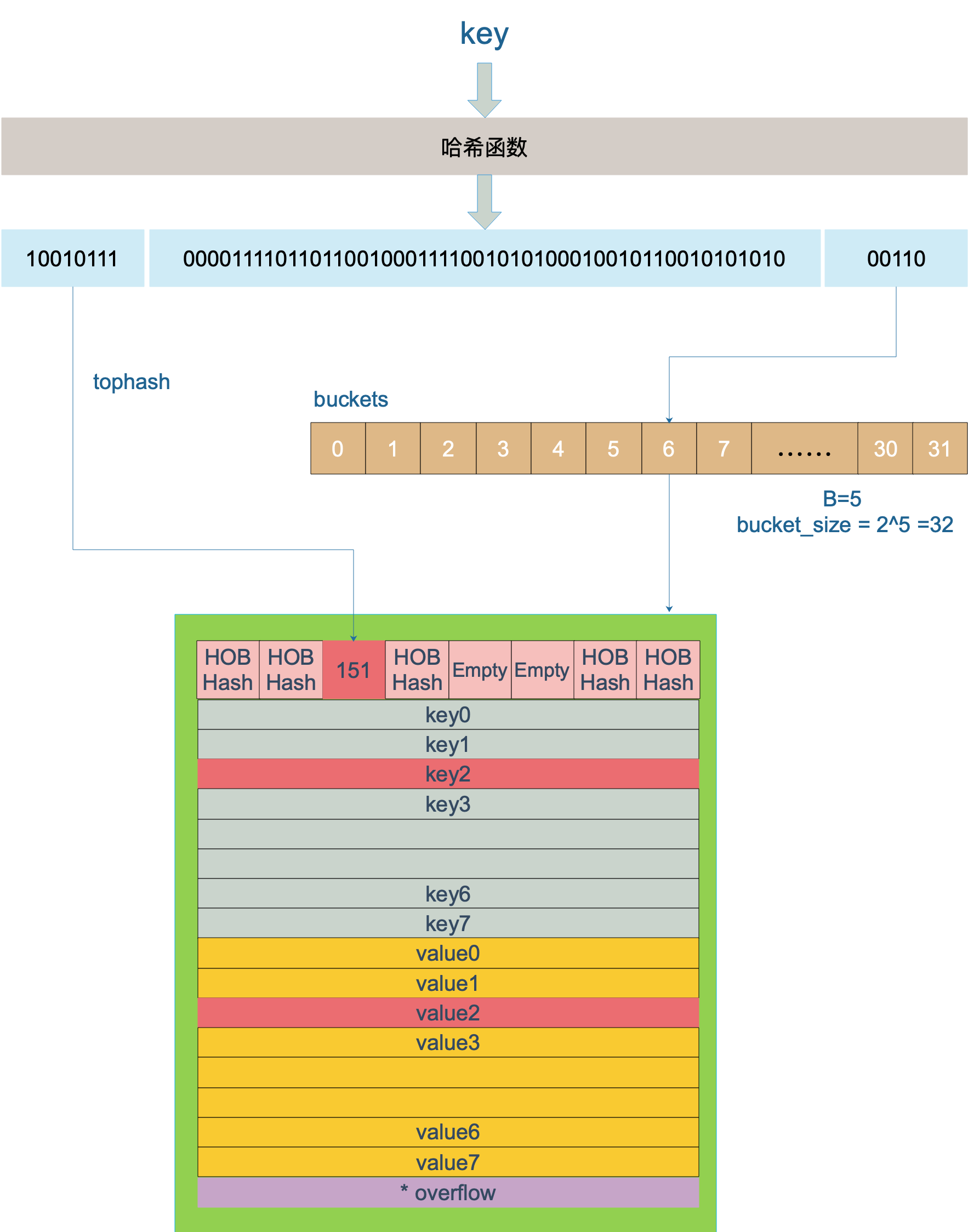array
在 Go 语言中我们通过如下方式声明数组类型:
1
2
| [5]int
[10]interface{}
|
数组类型包含数组长度以及元素类型,长度不同或者元素类型不同的数组是不同类型的
1
2
3
4
5
6
7
8
9
| var (
a [2]int
b [3]int
c [2]interface{}
d [3]interface{}
)
fmt.Printf("a type:%T,b type:%T,c type:%T,d type:%T\n", a, b, c, d)
// output
// a type:[2]int,b type:[3]int,c type:[2]interface {},d type:[3]interface {}
|
数组长度可以根据字面量进行推导,可以通过下面的方式初始化数组,编译时会自动推导数组长度
1
2
3
4
| e := [...]int{1, 2, 3}
fmt.Printf("%T\n", e)
// output
// [3]int
|
可以通过内置函数len 获取数组长度
1
2
3
4
| f := [8]int{}
fmt.Printf("len:%d,cap:%d\n", len(f), cap(f))
// output
// len:8,cap:8
|
slice
切片是变长数组的实现方案,切片类型如下:
1
2
3
4
| var ss []int
fmt.Printf("%T\n", ss)
// output
// []int
|
运行时结构为:
1
2
3
4
5
| type slice struct {
array unsafe.Pointer //指向底层数组的指针
len int
cap int
}
|
可通过内置函数 len 获取长度,cap 获取容量,append进行元素追加
初始化
直接使用
未初始化的切片等于nil,可以直接使用。因为切片实际上是一个结构体,声明一个切片时,所有字段初始化为零值
1
2
3
4
5
6
7
| var ss []int
fmt.Printf("%p,%p,%d,%d,%t\n", &ss, ss, len(ss), cap(ss), ss == nil)
ss = append(ss, 1)
fmt.Printf("%p,%p,%d,%d\n", &ss, ss, len(ss), cap(ss))
// output
// 0xc0001346d8,0x0,0,0,true
// 0xc0001346d8,0xc00012a738,1,1
|
注意:当我们使用 %p 打印切片时,打印的实际上是底层数组的地址
通过字面量初始化
通过 make 初始化切片
1
2
3
4
| s6 := make([]int, 2, 6)
fmt.Printf("%p,%d,%d\n", s6, len(s6), cap(s6))
// output
// 0xc00002c210,2,6
|
make 操作在编译时会根据切片大小、容量以及是否发生逃逸,来决定行为:
- 当切片足够小且没有发生逃逸时会直接分配数组,然后对数组进行切片操作获得切片
1
2
| var arr [4]int
s := arr[:]
|
- 否则转化为对
runtime.makeslice调用在堆上分配
下标操作
可以通过下标操作s[a:b:c]从已有数组或切片获取一个新的切片,新的切片共享底层数组,操作中 a 不指定默认为 0,b 不指定默认为 len(s),c 不指定默认为 cap(s),新生成的切片 len=b-a,cap=c-a
1
2
3
4
5
6
7
8
9
10
11
12
13
14
15
16
| a := [5]int{}
fmt.Printf("addr:%p,len:%d,cap:%d\n", &a, len(a), cap(a))
s1 := a[:]
fmt.Printf("addr:%p,len:%d,cap:%d\n", s1, len(s1), cap(s1))
s2 := s1[1:]
fmt.Printf("addr:%p,len:%d,cap:%d\n", s2, len(s2), cap(s2))
s3 := s1[1:2]
fmt.Printf("addr:%p,len:%d,cap:%d\n", s3, len(s3), cap(s3))
s4 := s1[1:2:3]
fmt.Printf("addr:%p,len:%d,cap:%d\n", s4, len(s4), cap(s4))
// output
//addr:0xc00002c240,len:5,cap:5
//addr:0xc00002c240,len:5,cap:5
//addr:0xc00002c248,len:4,cap:4
//addr:0xc00002c248,len:1,cap:4
//addr:0xc00002c248,len:1,cap:2
|
扩容
当通过append操作追加元素时,元素数量超过切片的容量时,切片会发生扩容。
扩容操作本质上是开辟一个新的容量足够大的数组,将原来的数组元素复制到新数组,将切片的数组指针指向新数组,新数组的容量选取需要考虑两方面的因素:
- 扩容操作会涉及到内存拷贝,是一个比较耗时的操作,所以需要尽可能减少扩容发生的概率
- 尽量避免内存浪费,新分配的内存尽可能多的使用,原有的内存能够有效的回收
基于以上考虑,运行时根据切片的当期容量选择不同扩容策略:
- 如果期望容量大于当前容量的两倍就会使用期望容量;
- 如果当前切片的长度小于 1024 就会将容量翻倍;
- 如果当前切片的长度大于 1024 就会每次增加 25% 的容量,直到新容量大于期望容量;
string
运行时结构如下
1
2
3
4
| type stringStruct struct {
str unsafe.Pointer //指向[]byte的指针
len int
}
|
字符串的字面量形式
1
2
3
4
| s:="hello world"
s1:=`a
b
`
|
字符串类型转化
1
2
3
| a:="hello world"
b:=[]byte(a)
c:=string(b)
|
实际上调用了runtime.stringtoslicebyte 和runtime.slicebytetostring函数
会进行内存拷贝
可以通过指针类型转换来避免内存拷贝
1
2
3
4
5
6
7
8
| // string to slice no copy
a:="abcde"
s := *(*reflect.SliceHeader)(unsafe.Pointer(&a))
s.Cap=len(a)
d:=*(*[]byte)(unsafe.Pointer(&s))
// slice to string no copy
b := []byte("abcde")
e := *(*string)(unsafe.Pointer(&b))
|
注意:通过指针将一个string转为slice后应该避免修改,否则会报异常,因为string 字面量是只读的
1
2
3
4
| d[0] = 'j'
// ouput
// unexpected fault address 0x15cfe93
// fatal error: fault
|
1
2
3
| aa := "hello world"
bb := []rune(aa)
cc := string(bb)
|
底层会调用runtime.stringtoslicerune 和 runtime.slicerunetostring 函数
字符串的拼接
1
2
3
| a:= "hello"
b:="world"
c:=a+" "+b
|
编译器会转化为对runtime.concatstrings函数的调用:
1
2
3
4
5
6
7
8
9
10
11
12
13
14
15
16
17
18
19
20
21
22
23
24
25
26
27
28
29
30
31
32
33
34
35
36
37
38
| // concatstrings implements a Go string concatenation x+y+z+...
// The operands are passed in the slice a.
// If buf != nil, the compiler has determined that the result does not
// escape the calling function, so the string data can be stored in buf
// if small enough.
func concatstrings(buf *tmpBuf, a []string) string {
idx := 0
l := 0
count := 0
for i, x := range a {
n := len(x)
if n == 0 {
continue
}
if l+n < l {
throw("string concatenation too long")
}
l += n
count++
idx = i
}
if count == 0 {
return ""
}
// If there is just one string and either it is not on the stack
// or our result does not escape the calling frame (buf != nil),
// then we can return that string directly.
if count == 1 && (buf != nil || !stringDataOnStack(a[idx])) {
return a[idx]
}
s, b := rawstringtmp(buf, l)
for _, x := range a {
copy(b, x)
b = b[len(x):]
}
return s
}
|
该函数会计算出最终字符串的长度,一次分配内存空间给目标串,再把待拼接字符串依次拷贝到目标串
- 通过
strings.Builder 高效构建字符串
1
2
3
4
5
6
7
8
| sb := strings.Builder{}
sb.Grow(11)
sb.WriteString("hello")
sb.WriteByte(' ')
sb.WriteString("world")
fmt.Println(sb.String())
// output
// hello world
|
strings.Builder 用一个字节切片作为容器
1
2
3
4
| type Builder struct {
addr *Builder // of receiver, to detect copies by value
buf []byte
}
|
通过提前预估容量,调用Grow函数,可以有效的减少内存分配次数
1
2
3
4
5
6
7
8
9
10
11
12
13
14
15
16
|
func (b *Builder) grow(n int) {
buf := make([]byte, len(b.buf), 2*cap(b.buf)+n)
copy(buf, b.buf)
b.buf = buf
}
func (b *Builder) Grow(n int) {
b.copyCheck()
if n < 0 {
panic("strings.Builder.Grow: negative count")
}
if cap(b.buf)-len(b.buf) < n {
b.grow(n)
}
}
|
String函数通过指针强制转换避免了从字节切片到字符串的内存拷贝
1
2
3
4
| // String returns the accumulated string.
func (b *Builder) String() string {
return *(*string)(unsafe.Pointer(&b.buf))
}
|
map
Go 语言中的 map 实现为 hash 表,运行时结构为:
1
2
3
4
5
6
7
8
9
10
11
12
13
14
15
16
| // A header for a Go map.
type hmap struct {
// Note: the format of the hmap is also encoded in cmd/compile/internal/gc/reflect.go.
// Make sure this stays in sync with the compiler's definition.
count int // # live cells == size of map. Must be first (used by len() builtin)
flags uint8
B uint8 // log_2 of # of buckets (can hold up to loadFactor * 2^B items)
noverflow uint16 // approximate number of overflow buckets; see incrnoverflow for details
hash0 uint32 // hash seed
buckets unsafe.Pointer // array of 2^B Buckets. may be nil if count==0.
oldbuckets unsafe.Pointer // previous bucket array of half the size, non-nil only when growing
nevacuate uintptr // progress counter for evacuation (buckets less than this have been evacuated)
extra *mapextra // optional fields
}
|
可用 len 获取 map 的长度
map 中实际存储键值对的容器是bucket(桶),运行时结构为bmap,一个 bucket 可以存放 8 个键值对
1
2
3
4
5
6
7
| type bmap struct {
topbits [8]uint8
keys [8]keytype
values [8]valuetype
pad uintptr
overflow uintptr
}
|
map 的内存结构如下图:

初始化
未初始化的 map 等于nil,对其进行写操作会报异常,我们申明的 map 类型变量实际上是 *hmap 类型的。
1
2
3
4
5
6
7
8
9
10
| var m1 map[string]int
fmt.Printf("%p,len:%d,size:%v,is nil:%t\n", m1, len(m1), unsafe.Sizeof(m1), m1 == nil)
// output
// 0x0,len:0,size:8,is nil:true
fmt.Println(m1["a"])
// output
// 0
m1["a"]=1
// output
// panic: assignment to entry in nil map
|
字面量初始化
1
| m:=map[int]string{1:"abc",2:"cbe"}
|
make初始化
可以指定初始容量
1
2
| m1:=make(map[int]string)
m2:=make(map[int]string,2)
|
无论是字面量还是make函数,都会被 Go 语言编译器在类型检查期间转化为runtime.makemap 调用
1
2
3
4
5
6
7
8
9
10
11
12
13
14
15
16
17
18
19
20
21
22
23
24
25
26
27
28
29
30
31
32
33
34
| func makemap(t *maptype, hint int, h *hmap) *hmap {
mem, overflow := math.MulUintptr(uintptr(hint), t.bucket.size)
if overflow || mem > maxAlloc {
hint = 0
}
// initialize Hmap
if h == nil {
h = new(hmap)
}
h.hash0 = fastrand()
// Find the size parameter B which will hold the requested # of elements.
// For hint < 0 overLoadFactor returns false since hint < bucketCnt.
B := uint8(0)
for overLoadFactor(hint, B) {
B++
}
h.B = B
// allocate initial hash table
// if B == 0, the buckets field is allocated lazily later (in mapassign)
// If hint is large zeroing this memory could take a while.
if h.B != 0 {
var nextOverflow *bmap
h.buckets, nextOverflow = makeBucketArray(t, h.B, nil)
if nextOverflow != nil {
h.extra = new(mapextra)
h.extra.nextOverflow = nextOverflow
}
}
return h
}
|
总结一下,初始化过程包括:
- 创建 hmap 变量
- 初始化 hmap 中的字段(主要是 bucket 数组)
访问
1
2
| m:=map[int]string{1:"dog",2:"cat"}
fmt.Println(m[1])
|
- comma_ok 形式,ok 字段表示 key 是否存在
1
2
| m:=map[int]string{1:"dog",2:"cat"}
v,ok:=m[2]
|
这两种访问对应运行时函数runtime.mapaccess1 和runtime.mapaccess2 函数。
key的查找过程如下图:

- 计算key的hash
- 根据hash的低B位在bucket数组中找到bucket
- 根据hash的高8位与bucket中的tophash数组进行比对,找到key的位置
遍历
可以通过 range 关键字遍历 map,注意遍历的顺序是随机的
1
2
3
4
5
6
7
8
9
10
| m2 := map[int]string{
1: "cat",
2: "dog",
}
for k, v := range m2 {
fmt.Println(k, v)
}
// output
// 1 cat
// 2 dog
|
编译器会重写for-range循环,将其换为对运行时函数runntime.mapiterinit和runtime.mapiternext的调用
1
2
3
4
5
6
7
8
| ha := a
hit := hiter(n.Type)
th := hit.Type
mapiterinit(typename(t), ha, &hit)
for ; hit.key != nil; mapiternext(&hit) {
key := *hit.key
val := *hit.val
}
|
遍历的过程就是遍历每个bucket及其overflow bucket的过程,由于扩容的存在,会涉及到遍历新老bucket的问题。
遍历过程:
- 创建一个迭代器并初始化(主要是确定初始bucket和初始cell)
- 不断地获取下一个bucket进行遍历,直到回到起始bucket
此过程的难点在于2 倍扩容时,老 bucket 会分裂到 2 个新 bucket 中去。而遍历操作,会按照新 bucket 的序号顺序进行,碰到老 bucket 未搬迁的情况时,要在老 bucket 中找到将来要搬迁到新 bucket 来的 key。
写入
可以通过下标的方式进行写入
1
2
3
| m:=map[int]string{1:"abc",2:"cbe"}
m[1]="ccc"
m[3]="ddd"
|
编译器会将其转换为对运行时函数runtime.mapassign的调用,写入分为更新和新增,无论哪种都得先查找 key 所在的位置,查找的过程同访问的过程,如果查找到 key,则对其 value 进行更新,否则新增 kv。新增 kv 会进行扩容检查,如果满足条件,会进行扩容。
删除
可通过内置函数 delete 删除数组元素
1
2
| m:=map[int]string{1:"aaa"}
delete(m,1)
|
运行时实际调用的函数为runtime.mapdelete
删除的过程:
- 判断flags标记,如果有写标记,则直接报异常"concurrent map writes"
- 根据key的hash找到bucket,如果map处于扩容中,则触发一次搬迁操作
- 找到key和value并清空,并设置对应tophash为emptyOne
- 将count减一
扩容
底层容器为数组,所以会涉及到扩容。扩容操作会涉及所有 bucket 的迁移,这是一个比较耗时的过程,所以扩容实现为渐进式扩容,当扩容开始后,每次对 map 的写操作会搬迁 1~2 个 bucket。
- 当负载因子超过6.5时会发生翻倍扩容
- 当溢出桶的数量过多时会发生等量扩容
参考

